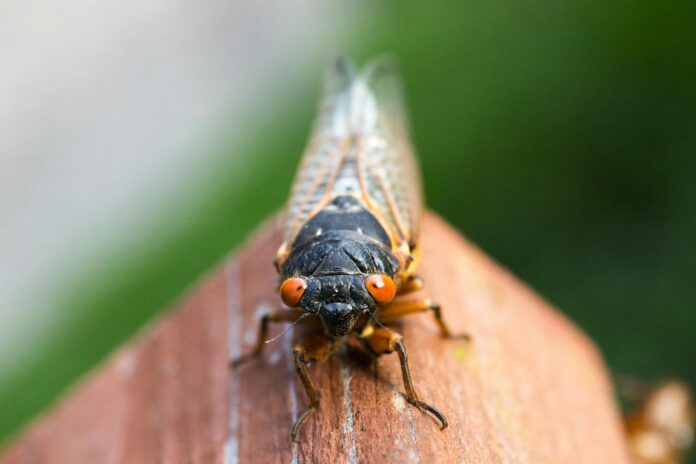Listen closely. Do you hear it? If you’re outside or near a window, chances are you are hearing the incessant, whirring call of cicadas.
It’s been 13 years since this particular group of cicadas — called Brood XIX — last emerged in Georgia and other parts of the Southeast and Midwest. Additionally, in the Midwest, the 17-year Brood XIII is also emerging, resulting in trillions of cicadas rising from the earth.
The last time these specific broods emerged together was 1803, when Thomas Jefferson was president.
Entomologist Dr. Alan Smith, professor emeritus of biology in the College of Liberal Arts and Sciences at Mercer University, explained what’s going on with these noisy insects.
Where did all these cicadas come from?

The ground! For the first 13 or 17 years of their lives, these cicadas lived underground. They hatched from eggs and grew into nymphs, molting multiple times as they matured.
If you look at one of their abandoned exoskeletons — it may be dangling from a tree or stuck on the side of a house — you can get an idea of what they looked like underground.
“The nymphs are very good at digging. So, if you look at them, they have enlarged forelimbs modified for burrowing,” Dr. Smith said. “Their piercing-sucking mouthparts allow them to feed on the sap of plant roots.”
Cicadas get all their nourishment underground and don’t eat once they emerge.
“All their energy that they have for everything they need to do, they’ve stored,” he said.
And what exactly is it that they need to do?
“It’s all about reproduction,” Dr. Smith said.
Once the cicadas emerge, it takes at least 24 hours for them to start mating. In this time, the wings extend and harden enough to support flight, and eggs in the females finish developing.
The noise you hear comes from male cicadas seeking a mate. Once they mate, the females make little slits in tree branches to lay their eggs. The eggs develop into tiny nymphs, which drop and burrow underground, where they will grow and develop for the next 13 or 17 years.
Brood XIX will next emerge in 2037 and Brood XIII in 2041.
Do all cicadas take this long to develop? I swear I hear them every year.
You do. In addition to periodical cicadas, like the 13-year Brood XIX that we’re experiencing now, Georgia has annual cicadas that appear every summer. This is also why you may see cicadas that look different. The ones with the red eyes are the ones that only emerge every 13 years.
The longer life cycles of periodical cicadas give them an advantage over annual cicadas.
Evolutionary biologists have theorized the cicadas’ lengthy time underground is an adaptation to help them avoid predators. Animals — including birds, reptiles, mammals and parasitic wasps — that prey on periodical cicadas have lifespans significantly shorter than 13 or 17 years.
“Consequently, few predators can anticipate and specialize in these insects as a food source,” Dr. Smith said.
Cicadas’ mass spawning, called “big bang” reproduction, also contributes to their survival.
“There’s such a huge reproductive output that there’s a good chance a large number will survive,” he said. “They escape predation.”
What role do cicadas play in the ecosystem?
Cicadas are a tremendous food source.
“Every 13 years (when Brood XIX emerges), there’s this massive injection of biological material, of food, into the ecosystem,” Dr. Smith said. “It’s assimilated into the tissues of all living things.”
Birds and other creatures eat cicadas. When cicadas die, their decayed bodies feed the plants.
“As the nymphs develop underground, they grow and accumulate significant quantities of proteins and lipids which will later serve for adult dispersal and reproduction,” Dr. Smith said. “Not only are the adults a food source for a variety of animals, but their bodies are broken down by bacteria and fungi, thereby fertilizing plants.”
How long will the emergence last?
The cicadas won’t be here for long. The whole emergence takes just five to six weeks. So, appreciate — or tolerate, if that’s more your speed — them in the meantime.
“They don’t bite. They’re harmless. They’re an important part of the ecosystem. They’re not major agricultural pests,” Dr. Smith said. “They’re a marvel of nature.”
He compared them to the main character in Kurt Vonnegut’s Slaughterhouse-Five. In the novel, Billy Pilgrim “is unstuck in time. He wakes up every now and then, but he’s in another place in time,” Dr. Smith said.
“And I think of cicadas that way — these 13- and 17-year locusts — because they emerge in prime number years. They’re escaping in time from their predators, and that’s why they’re so successful. It’s an extreme reproductive strategy, but it’s an amazing one.”










